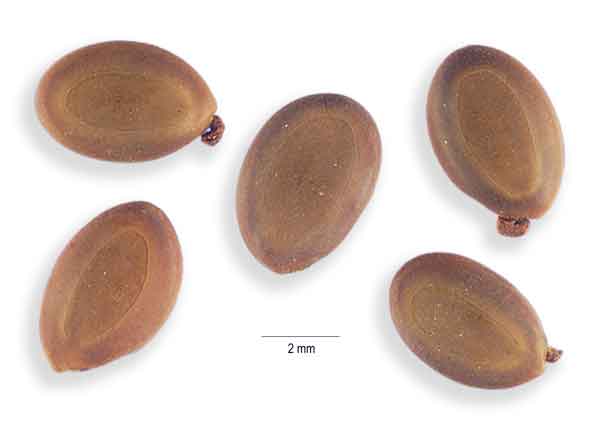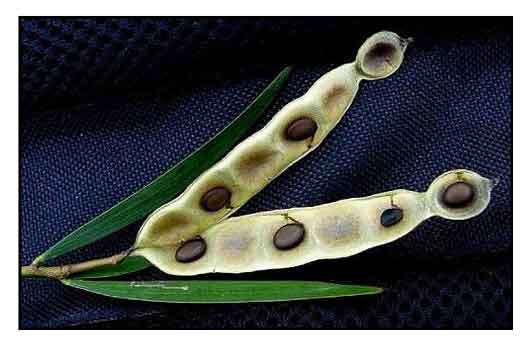 Gen info Gen info
- Acacia is a large genus of shrubs and tress in the subfamily Mimosoideae of the pea family Fabacea.
- The genus name is New Latin, borrowed from Greek akakia.
- Acacia is a widely used common name across genera.
Botany
Acacia confusa is an evergreen tree, 6-15 m tall, glabrous. Branches gray or brown, unarmed; branchlets slender, angular. Phyllodes straight or slightly falcate, linear-lanceolate, 6-10 × 0.5-1.3 cm, leathery, both surfaces glabrous, conspicuous longitudinal veins (3-)5(-8), both ends acuminate, apex slightly obtuse, usually with hooked acumen. Heads solitary or 2- or 3-fasiculate, axillary, globose, ca. 0.7 cm in diam.; peduncles 7-13 mm, slender. Flowers golden yellow, fragrant. Calyx 1-1.3 mm. Petals greenish, 1.5-1.9 mm. Stamens numerous, ca. 3.5 mm. Ovary yellow-brown villous; style ca. 4 mm. Legume black-brown, flat, 4-9(-12) × 0.7-1 cm. Seeds broadly elliptic, 5-6 × 3.5-5 mm. (Flora of China) (2)
Distribution
- Native to the Philippines.
- Grows primarily in the wet tropical biome.
- Also native to Borneo, Malaya, Sumatera, Taiwan.
(1)
- In Hawaii, the species is considered moderately invasive.
 Constituents Constituents
- Study for secondary metabolites have isolated phenolic acid derivatives and flavonoids from different plant parts: 55 compounds, including 13 phenolic acid derivatives, 13 flavonol glycosides, 1 lignan and 4 alkaloids. Heartwood and root extract yield flavonoids and phenolic acid derivatives. Bark is mostly phenolic acid and caffeic acid derivatives. Leaves, branches, twigs, flowers, and buds contain flavonol glycosides, some flavonoids, and phenolic acid derivatives. (3)
- Column chromatography and reverse-phase high-performance liquid chromatography of ethanolic extracts of heartwood isolated 10 pure phenolic compounds, including three major antioxidants, 3,7,8,3‘,4‘-pentahydroxyflavone, 7,8,3‘,4‘-tetrahydroxy-3-methoxyflavone, and 3,4,2‘,3‘,4‘-pentahydroxy- trans-chalcone and a new flavonoid 3,7,8,3‘- tetrahydroxy-4‘-methoxyflavone. (see study below) (6)
-
Column chromatography and reverse-phase high-performance liquid chromatography of EtOAc fraction isolated 13 specific phytocompounds including 5 new flavonoids (i.e., 7,8,3',4'-tetrahydroxy-4-methoxyflavan-3-ol, 7,8,3',4'-tetrahydroxyflavone, 7,8,3'-trihydroxy-3,4'-dimethoxyflavone, 7,3',4'-trihydroxyflavone, and 7,3',4'-trihydroxy-3-methoxyflavone). (see study below) (7)
- List of psychoactive alkaloids from various plant parts: 0.074% alkaloids from stems (20% DMT, 80% NMT);[33] NMT and an unidentified tryptamine alkaloid from trunk bark;[34][35] 2.85% alkaloids from root bark (45% DMT, 55% NMT);[36] 0.005% DMT, 0.009% DMT N-oxide, 0.006% NMT and 0.007% N-chloromethyl-DMT (might be artefact of extraction) from unspecified parts[37]. (8)
Properties
- Studies have suggest antioxidant, hepatoprotective, antihyperuricemic, anti-inflammatory, antifungal, antinociceptive, immune-regulatory properties.
 Toxicity Toxicity
- Toxicity relates mostly to psychoactive alkaloids constituents. There are published articles referring to psychedelic and hallucinogenic effects. However, there is a lack of accessible bioassay reports and scientific studies.
- Roots reported used in ayahuasca analogs.
- Report (Liu et al, 1977) mentions 1.15% DMT in the roots.
- Seeds considered poisonous and reported to cause headache when ingested.
- Seeds contain neurolathryogen, i.e. α-amino-ß-oxalylaminopropionic acid, which can cause neurological damage, paralysis and death. (13)
- Wiki.dmt-nexus provides links on some reports and studies. (13)
- Oral dosing of DMT via ayahuasca produces both behavioral and neurochemical effects, such as decreases in motor activity, impairment of cognitive function, sympathomimetic effects, increase prolactin and cortisol levels, and decreased lymphocyte increased natural killer cells. (14)
Parts used
Bark, heartwood, seeds, leaves.
Uses
Edibility
- There is a dearth of information on edibility.
- Bark ground into a powder reportedly used for making tea or used as spice.
 Folkloric Folkloric
- No reported folkloric medicinal use in the Philippines.
-
In China, used as muscle relaxant and for treatment of blood disorders. Roots reportedly used for detoxification, treating liver and laryngeal inflammations.
- In Taiwan, leaves applied for wound healing; used as antiblood stasis.
Others
- Wood: Stems and roots are hard and extremely strong. Sapwood is yellow; heartwood, chocolate brown from tannins.
(3) Wood is challenging to work with, and found traditional use as firewood and charcoal. In Taiwan, wood used to make support beams for underground mines. Later, it was exported to China to be made into flooring material for the American market. At the height of this commerce, Taiwan export3d more than 1,000 containers of Taiwan acaciia to China. It has recently found use for furniture and musical instruments. (4)
- Fuel: Used as firewood or for making charcoal.
- Entheogen: Contains constituents and alkaloids used as entheogens (substances typically of plant origin ingested to produce altered states of consciousness for religious or spiritual purposes). DMT is one of the major psychoactive constituents found in various shamanistic compounds (e.g. ayahuasca, hoasca, yagé used for centuries in South America, recently finding its way into Europe and North America as a recreational drug. (14)
Studies
• Antioxidant / Phenolic Compounds: Evaluation of antioxidant potency of extracts from different plant parts shows the root extract has the highest total phenolic contents (TPC) (652.2 mg gallic acid equivalent (GAE/g), followed by heartwood extract (529.7 mg GAE/g), bark extract (470 ,g GAE/g), branches (348.2 mg GAE/g), leaves (190.2 mg GAE/g), buds (173.3 mg GAE/g), twigs (121.4 mg GAE/g) and flowers (105 mg GAE/g). Of the flavonoids, okanin and melanoxetin are the strongest antioxidant flavonoids with lowest IC50s of radical scavenging against DPPH and superoxide radicals. Gallic acids found in bark, leaves, flowers, and bud extracts showed remarkable DPPH and superoxide radical scavenging activity with IC50s of 8.2 and 12.4 µM. (3)
• Hepatoprotective / Gallic Acid / Carbon Tetrachloride Toxicity / Bark: The ethyl acetate fraction of A. confusa bark extract and its active compounds, gallic acid, demonstrated excellent protective effect against CCl4-induced chronic liver injury in rats. (3)
• Inhibition of Xanthine Oxidase / Antihyperuricemic / Heartwood: Study evaluated the antihyperuricemic effect of A. confusa heartwood extracts on potassium oxonate (PO)-induced acute hyperuricemia in mice. Serum uric acid level was significantly suppressed by heartwood extracts and their major phytochemicals, (−)-2,3-cis-3,4-cis-3,3′,4,4′,7,8-hexahydroxyflavan, (−)-2,3-cis-3,4-cis-4′-methoxy-3,3′,4,7,8-pentahydroxyflavan, melanoxetin, transilitin, and okanin. Among them, melanoxetin showed more remarkable inhibitory effect on XOD activity than allopurinol, a drug used for XOD inhibition. Results showed strong inhibitory effects, which reduced serum uric acid while inhibiting uric acid generation in purine metabolism. (5)
• Antioxidant / Heartwood: Ethanolic extracts from heartwood of A. confusa exhibited strong antioxidant effects. Of all fractions, the EtOAc soluble fraction exhibits the best antioxidant activity, with 80% DPPH inhibitory activity at concentration of 5 µg/mL, and at same dosage similar to ascorbic acid and (+)-catechin. (see constituents above) (6)
• Anti-Inflammatory / Heartwood: Study evaluated the anti-inflammatory activity of heartwood extracts. Results showed ethanolic extracts of heartwood strongly suppressed NO production in lipopolysaccharide (LPS)-activated RAW 264.7 macrophages. The EtOAc exhibited the best inhibitory activity. Melanoxetin, a major compound in the EtOAc fraction, markedly suppressed LPS-induced NO and prostaglandin E2 (PGE2) production and completely suppressed gene expression of inducible NO synthase (iNOS) and cycloxygenase-2 (COX-2). (see constituents above) (7)
• Anti-Inflammatory / Antinociceptive / Indole Alkaloids / Bark: Study evaluated the antinociceptive and anti-inflammatory activities of indole alkaloids from the bark of A. confusa. A pair of novel trimeric indole alkaloid enantiomers, five new bisindole alkaloids, and three pairs of new monomeric indole alkaloid enantiomers, together with seven known alkaloids were isolated from the bark. Compounds 4 and 11-16 exhibited significant antinociceptive activities in an acetic acid-induced writhing test. Compounds (+)-9 and (-)-9 exhibited anti-inflammatory activities through inhibition of NF-kB pathway, with inhibitory rates of 68.9% and 59.5%, respectively, at concentration of 10 µM. (9)
• Free Radical-Scavenging / Leaves: Study evaluated hot water extracts of A. confusa leaves for phytochemicals and antioxidant activities. Among all fractions, the EtOAc-soluble fraction showed the best DPPH radical-scavenging activity, superoxide radical-scavenging activity, and reducing power. SPE and reverse-phase HPLC yielded we pure phenolic compounds, including five major compounds (gallic acid, (+)-catechin, (-)-epicatechin, myricetin 3-glucopyranoside, and myricetin 3-rhamnopyranoside). Results showed excellent antioxidant activities and great potential as a source of natural health products. (10)
• Acafusin / Dimeric Antifungal Protein / Seeds: A dimeric 34-kDa antifungal protein, acafusin, was purified from A. confusa seeds. Acafusin exhibited antifungal activity toward Rhizoctonia solani with IC50 of 28 µM. It also mildly inhibited the activity of HIV-1 reverse transcriptase with IC50 of 80 µM. (11)
• Antioxidant / Bark and Heartwood: Study evaluated the antioxidant activity of extracts from bark and heartwood of Acacia confusa using various assays i.e. free radical and superoxide radical scavenging assays and lipid peroxidation assay as well as OH radical-induced DNA strand scission assay. Results showed both bark and heartwood have strong antioxidant effects. (12)
• Neuropharmacology of DMT: N,N-dimethyltryptamine (DMT) is an indole alkaloid widely found in plants and animals, which is best known for producing brief and intense psychedelic effects when ingested. Studies suggest endogenous DMT plays important roles in peripheral and central nervous system processes. Study reviews literature on recreational use of DMT and its potential roles as an endogenous neurotransmitter, reporting on pharmacokinetics, mechanisms of action, clinical uses and adverse effects. DMT appears to have limited neurotoxicity and other adverse effects except for intense cardiovascular effects when administered intravenously in large doses. While some reports suggest it to be neurotoxic, recent research suggest it may actually be neuroprotective. Study suggests potential role as a clinical tool for treatment of anxiety and psychosis. (14)
• Immune-Regulatory Activity / Melanoxetin / Heartwood: Study evaluated the immune-regulatory activity of methanolic extract of heartwood of A. confusa and its effect on dendritic cell (DC) activation and function. The MHE significantly reduced production of pro-inflammatory cytokine interleukin-6 (IL-6) in lipopolysaccharide (LPS)-stimulated DCs, and the effective concentration (25 µg/ml) did not affect cell viability. Melanoxetin, isolated and purified by HPLC, inhibited the production of inflammatory cytokines (TNF-α, IL-6, and IL-12) in LPS-stimulated DC at concentration of 12.5 µM. Study suggests A. confusa MHE and melanoxetin possess excellent immune-suppressive activity, with potential for development as a natural health supplement. (15)
• Immune-RegulatoryActivity / Melanoxetin / Heartwood: Photostabilizers are organic compounds that help prevent UV filters from losing their effectiveness in sunlight. Study evaluated whether heartwood extracts of Acacia confusa (HEAc) can be used as commercial photostabilizers. 1% HEAc treatment showed similar effectiveness compared with UV absorber (EV80), while 5 and 10% HEAc treatments showed better effectiveness than EV80 treatment. HEAc can absorb UV light and quench radicals; hence, can prevent wood photodegradation. Results suggest potential as a natural photostabilizer. (16)
• Anti-Hepatitis C Virus Activity / Suppression of COX-2 / Dried Stems: Study reports on an
n-butanol-methanol extract from Acacia confusa (ACSB-M4), which exhibited the inhibition of HCV RNA replication in the HCV replicon assay system, with EC50 and CC50/EC50 selective index (SI) of 5 ± 0.3 µg/ml and > 100, respectively. ACSB-M4 showed antiviral synergy in combination with IFB-α and as HCV protease inhibitor (Telaprevie;VX-950) and polymerase inhibitor (2'-C-methylcytidine; NM-107). Results suggest the anti-HCV activity of ACSB-M4 was associated with down-regulation of COX-2, which correlated with suppression of NF-kB activation. Study suggests ACSB-M4 has potential as protective agent for use in the management of chronic HCV infection. (17)
Availability
Wild-crafted.
Seeds in the cybermarket.
|

![]()





 Toxicity
Toxicity
